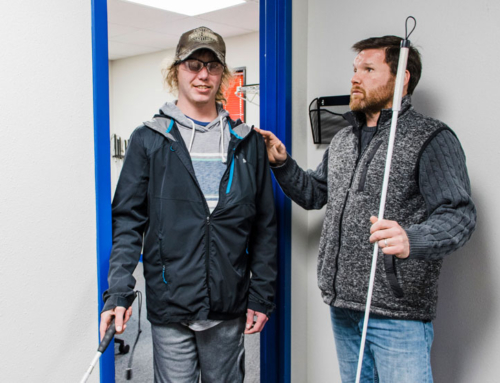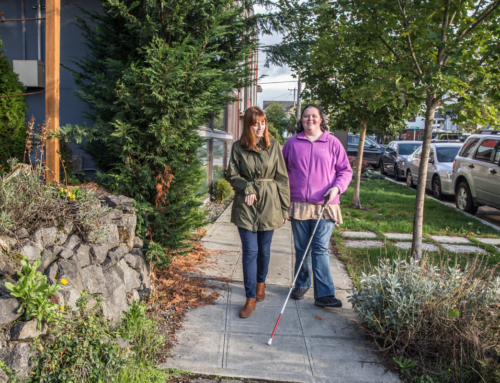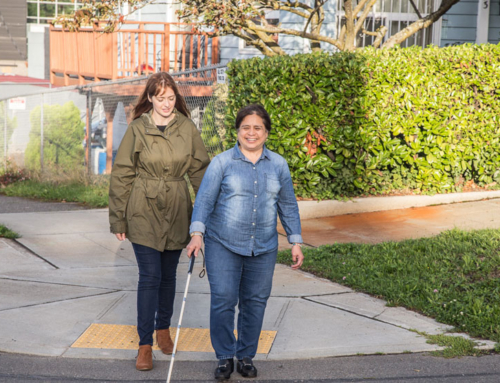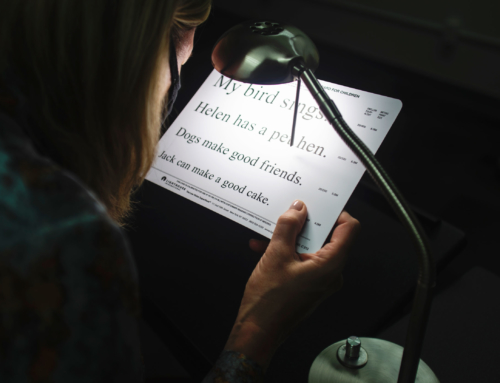White Cane Safety Day is Friday, October 15! This holiday is dedicated to raising awareness for the long white canes that many people who are blind use to navigate the world around them.
What is a White Cane?
Erin Fitzpatrick is a Supervisor of Orientation & Mobility Services at the Lighthouse. She describes a white cane as, “a tool to get information about your surroundings when you can’t see them.”
She continues, “as you’re walking, the bottom tip of the cane is scraping along the ground. It’s creating vibrations that go up the cane, into your hand, your wrist, and up all those nerves into the brain. Then, your brain does that magical thing where it decodes it for you. And you’re able to understand sensations.”
The Importance of White Canes
White canes are important mobility tools for their users. White canes allow people who are blind, DeafBlind, or visually impaired to navigate the world around them safely and independently.
Erin notes, “being able to move through your environment and go places without having to rely on a sighted person is extremely important to someone’s independence and empowerment.”
Tim Paulding, ECS Services & Instructional Manager at the Lighthouse, describes just how much of a difference a white cane can make. He notes, “several people here at the Lighthouse spent a few years or more at home. They were convinced that because they went blind their life was over. They thought that they had to have assistance doing everything. People just don’t know what kind of independence tools are out there. Providing people with information and tools, as well as the skills to take back control of their own lives, is huge.”
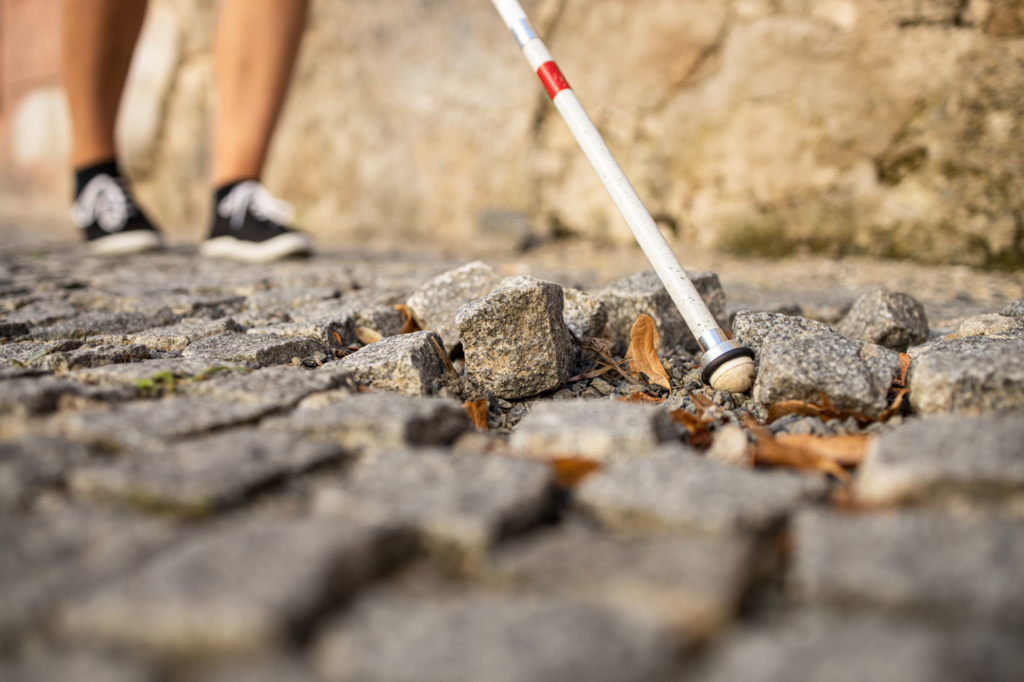
Up close image of a cobblestone sidewalk with the tip of a white cane over an area where the rock is loose.
Orientation & Mobility
One of the many services the Lighthouse offers to employees is Orientation & Mobility (O&M) training. “O&M refers to the fine art of traveling while blind,” Erin explains. “Orientation is about where things are. It’s about where you are, where you are in relation to those things, and where those things are in relation to each other. Mobility is about actually getting through all of that safely.”
“One of the really unique and important things about what we do here is that we provide services directly to our employees really before anything else. That means when somebody starts at the Lighthouse, they get immediate services,” Tim notes. “Your first day on the job an O&M instructor will assess you. They will figure out your basic needs, come up with some goals, and figure out how to get from work to home and home to work.”
O&M training at the Lighthouse not only covers white cane training. It also includes bus travel, route planning, assistive technology assessment, safety techniques for low-vision travelers, relocation and route planning for new community members, and supplemental training for guide-dog users. Learn more about orientation and mobility training here >>
White Cane Training
Tim is an O&M instructor and a white cane user himself. He explains, “what I do with someone who has never had any sort of services before, who is losing their vision or has gone totally blind, is we really start out with the basics of using the white cane.”
“So that’s how to hold the cane. How to move it back and forth in front of you and search for objects. How to walk confidently with it and recognize different landmarks. We work on how to get around the building first, and then move on to more complicated things like walking a sidewalk without stepping off the curb and avoiding poles. The next step is learning how to cross simple intersections. About crossing the street straight and not veering. Then, learning about crossing more complex intersections.”
“Detecting the difference between a hard floor like the production floor versus a carpet is something really apparent with a white cane. A first-time cane user could feel those surface or terrain changes. Those are things that the cane will tell you before you have to adjust what your body is doing. If you feel a drop off with that cane, you’ll have a step or two to adjust.”
“The lighter you touch something, the more information you’re going to receive from it,” he continues. “For example, when someone reads braille, they’re taught to rub their fingers over the dots on the page as gently as possible. The same goes for using the cane.”
“If someone becomes a real adept cane user it’s your eyes. It’s part of your body. It gathers information about what’s around you, what’s under your feet, and where to go. Once you’re skilled at it, that cane tip is providing you with very specific information.”
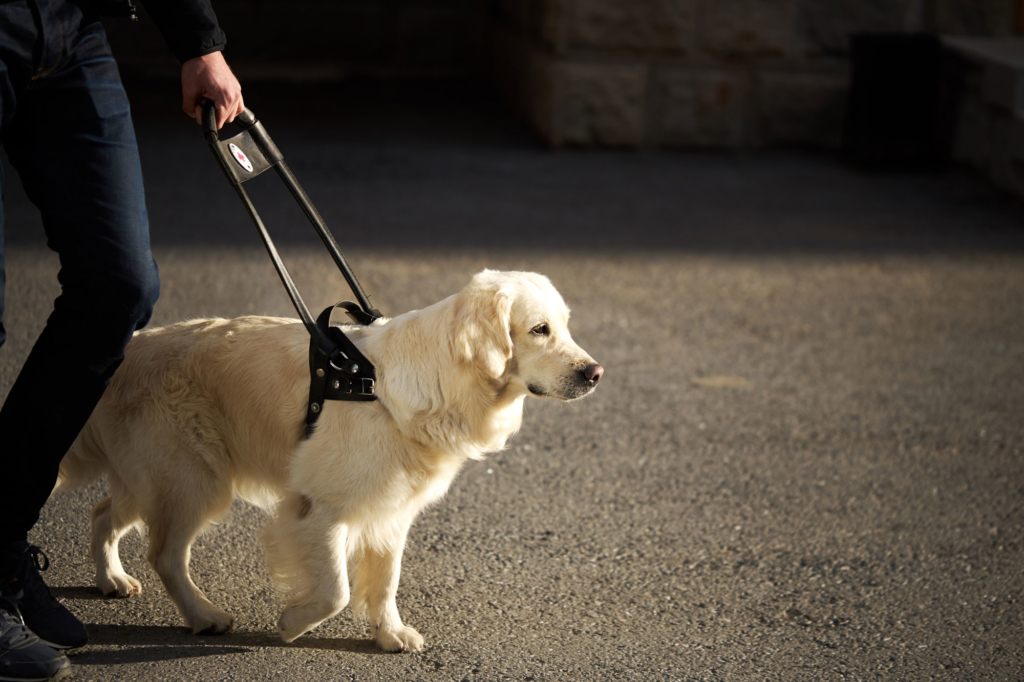
A blonde medium haired dog guide with a black harness. A hand is holding the handle of the harness.
White Canes and Dog Guides – What’s the Difference?
“The main difference in traveling with a dog versus traveling with a cane is that the cane is an obstacle detector, and a dog is an obstacle avoider,” Erin explains.
“With the cane you’re getting a lot more information. You’re getting information about the surface you’re walking on, information about things in your path. And, you are touching any drop offs before you get there.”
“With a dog, you don’t get a lot of that information. There’s a lot of trust with a dog. Something that people transitioning from a cane to a dog struggle with is that there’s suddenly a lot less environmental feedback.”
“The convenience tradeoff is that the dog is pretty good at taking you in a straight line. Potentially, you don’t have to stop at every obstacle. The dog can also be targeted to different things, so it makes it a little easier to find things,” she continues.
“It really comes down to personal preference and what someone is more comfortable with.”
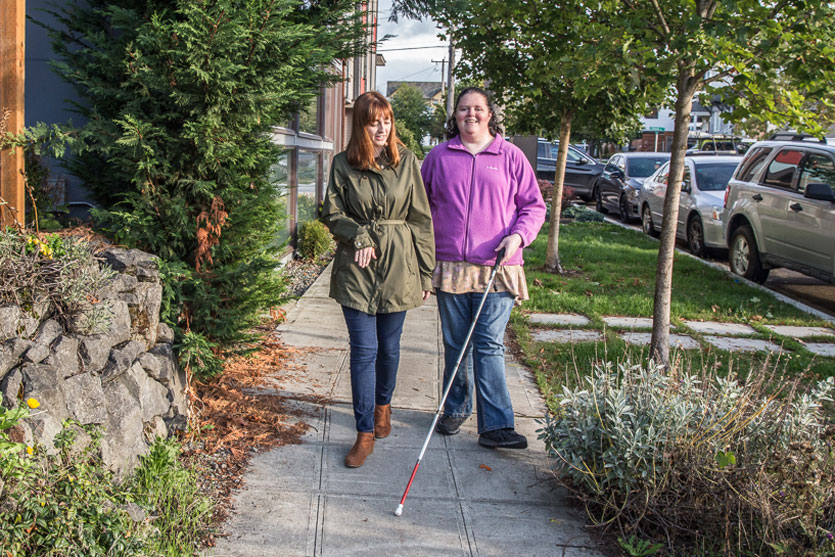
An Orientation and Mobility Specialist is waking with another woman on a sidewalk outside. One is using a white cane and holding on the elbow of the other.
Etiquette Around White Cane Users
“Oftentimes people in the public have never encountered a blind person before. They don’t know what to do. I’ve had tons of these experiences in my life,” Tim explains.
One of the most important things to remember when encountering someone using a white cane in public is to ask permission before physically intervening or interrupting them. Then, respect their wishes. Unfortunately, uninvited attempts to help someone can create a safety hazard.
Tim shares, “I’ve had people grab the end of my cane and pull me. Or grab my arm and pull me. As a sighted person, would you want someone grabbing and pulling you? You’re asking me to rely on a total stranger.”
“95 or 99% of the people that do these things, have great intentions. Why would they be helping someone if they didn’t? But it’s just a matter of educating a little bit on what’s appropriate.”
If someone is interested in assistance, use the sighted guide technique. This technique involves the sighted guide offering their elbow, which the person who is blind can then grab onto. This allows the guided to walk slightly next to and behind the guide safely.
It’s also important to remember that not everyone will be interested in using a guide. As described above, people using white canes can navigate their environment safely! Many prefer to do so independently & without the help of others.
“I think the biggest tip that would help to educate the public is that just because someone has a disability doesn’t mean that they automatically need help.”
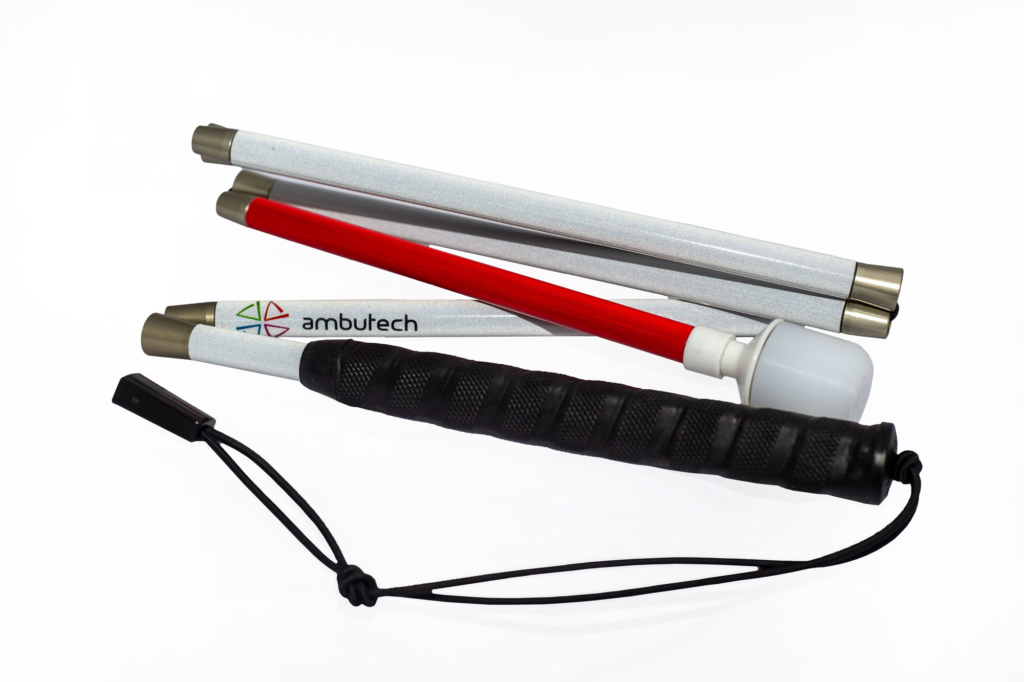
Close up image of a folded Ambutech cane with a marshmallow tip.
Where to Buy a White Cane
For most first-time cane users, a white cane is often gifted to them when they participate in O&M training. However, white canes come in a variety of types, shapes, and sizes!
Tim describes, “most people’s preferred cane is made by a company called Ambutech. They have an elastic band that goes through the middle of the cane. That allows the cane to fold into 4 or 5 pieces. You can fold it up and put it on your desk.”
Tim himself uses a different style, “the kind of cane I use is typically referred to as an NFB cane. It does not fold. It’s much longer and much lighter than the folding kind of standard canes that you see.”
Tim describes that there are also a multitude of cane tips. “The typical cane that we see here at the Lighthouse is a rolling marshmallow. It rolls! It’s got a very light ball bearing in it. So, when you move the cane side to side it smoothly rolls across the ground. It’s very easy for a beginner and it’s also very versatile for somebody who’s traveled a long way. When using this type of cane tip, there’s less strain on the forearm and the wrist in moving the cane back and forth, so people really love it. Another type is a pencil tip which is a small kind of straight tip. There’s a small metal tip that I use. So, according to the person’s preference, their skill level, and how fast they travel, they can pick between several different cane tips.
You can find all of these cane types, cane tips, and other mobility and assistive devices in our Low Vision Store.
We’re Leaders in Blind Employment – View Our Open Positions and Apply Today!
The Lighthouse for the Blind, Inc. transforms the lives of people who are blind, Deafblind, and blind with other disabilities. We are leaders in blind employment. Through employment opportunities, we are a catalyst for empowerment. We foster self-confidence and instill a life changing affirmation that independence is possible. From our expertise in cutting-edge technology to our understanding of mobility, we help people who are blind, Deafblind, and blind with other disabilities live fulfilling lives.


